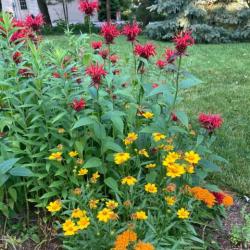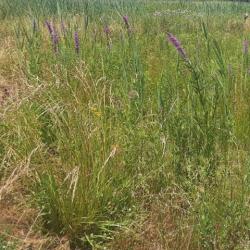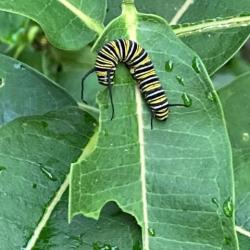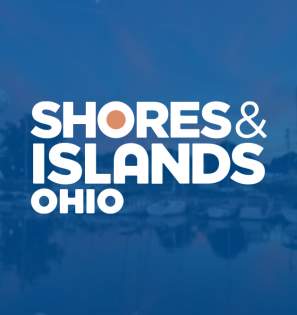 Part of our Time Traveler Series
Part of our Time Traveler Series
If you have stopped by our Shores & Islands Ohio Port Clinton Welcome Center, you may have noticed a bit of a change in the flower beds bordering our parking lot. This spring our office crew planted over 600 native flowers and grasses that over time will become a prairie meadow ecosystem. We have plans to create native gardens throughout our property over the next several years and are currently a member of Homegrown National Park (if you don’t know about this, check it out in the links below). There are many reasons why growing plants native to one’s region is important, and new evidence from ecologists, botanist, and entomologists are showing us just how important these plants are to our ecosystems!
Let’s take a step back in time to see what the landscape looked like prior to the building of cities, homes, and farms. When the earliest Europeans ventured through the Shores & Islands Ohio region, they came across (what appeared to be) untouched wilderness filled with native trees, flowers, grasses, and shrubs. Many of these plants, while extremely familiar to the indigenous people in the region, were unrecognizable to the colonists. Without the understanding of the importance and potential human uses of many of these plants, to the colonists the region looked like space to be drained or cleared and farmed. When these first colonizers arrived, they found several main types of habitats. One of the largest, which you can read about in one of my previous blogs, was the Great Black Swamp. While filled with interesting plant life, this  is not the habitat we will focus on. What we will focus on are the prairie habits that covered portions of the area. Ohio was home to several prairie habitats, including the Firelands Prairie and Castalia-Sandusky Bay Prairie. One can visit a well-preserved remnant of the Castalia-Sandusky Bay Prairie at Resthaven Wildlife Area near Castalia. The Firelands Prairie (or it’s remnants at least) is considered the one of the eastern most prairies in the country. These prairie habitats support (and supported) a large amount of life from butterflies, bees, and other insects, to larger ruminants such as the white-tailed deer. Turkeys and the now extirpated Prairie Chicken are (or were) also important parts of the prairie ecosystems.
is not the habitat we will focus on. What we will focus on are the prairie habits that covered portions of the area. Ohio was home to several prairie habitats, including the Firelands Prairie and Castalia-Sandusky Bay Prairie. One can visit a well-preserved remnant of the Castalia-Sandusky Bay Prairie at Resthaven Wildlife Area near Castalia. The Firelands Prairie (or it’s remnants at least) is considered the one of the eastern most prairies in the country. These prairie habitats support (and supported) a large amount of life from butterflies, bees, and other insects, to larger ruminants such as the white-tailed deer. Turkeys and the now extirpated Prairie Chicken are (or were) also important parts of the prairie ecosystems.
The indigenous people of the region knew how to harvest and use many of these plants, and some knowledge was passed along to a few colonists. But, overall, the native flora was viewed as “in the way” at worst, and a source of flowers for the floral industry at best. As the nation grew and expanded over the next hundred plus years, much of the natural land was taken over for homes, buildings, and farms. Our native flowers were particularly vulnerable as the floral industry grew. By 1925 a native Ohioan (a professor at the University of Cincinnati in fact) E. Lucy Braun started the Wildflower Preservation Society to address the preservation of native plant life. While the group dissolved in 1972, several of its offshoot organizations, including the Cincinnati Wildflower Preservation Society are still active to this day!
 Now, a closer look at why these native florae are important to a healthy ecosystem. Most readers are probably aware of the monarch butterfly’s plight, and particularly in its connection to the plants in the milkweed family (the only plant on which its caterpillars can feed). This is a perfect example of why native plants are important. While the monarch gets much press for its beauty and the harrowing journeys they embark on during migration, this is by far not the only creature tied to one particular variety of plant. In fact, native florae attract and support TONS of native pollinators from bees and butterflies to moths and even some wasp species. These pollinators are not only important to their native ecosystem but are also integral to the pollination of crops! Another example some may have heard of the is Karner Blue butterfly, whose caterpillars can only feed on native Lupine. It’s even believed that certain native species St. John’s wort are aided in germination by wild turkeys scratching open the soil. As ecologists continue learn, we are finding more and more connections between specific plants and specific species of animals and insects. These plants and animals have evolved together for thousands of years, and often related species from Europe or Asia, while similar to human eyes, do not contain the same nutrition or chemical make up as their North American counter parts. Another bonus of this long evolution is, if you pick the right spot, and find a plant native to your area, they have evolved to live in that particular setting and often thrive with little care. The list of plant/animal connections is too long to put in this blog, but I will give some native plant resources at the end so you can research on your own if interested.
Now, a closer look at why these native florae are important to a healthy ecosystem. Most readers are probably aware of the monarch butterfly’s plight, and particularly in its connection to the plants in the milkweed family (the only plant on which its caterpillars can feed). This is a perfect example of why native plants are important. While the monarch gets much press for its beauty and the harrowing journeys they embark on during migration, this is by far not the only creature tied to one particular variety of plant. In fact, native florae attract and support TONS of native pollinators from bees and butterflies to moths and even some wasp species. These pollinators are not only important to their native ecosystem but are also integral to the pollination of crops! Another example some may have heard of the is Karner Blue butterfly, whose caterpillars can only feed on native Lupine. It’s even believed that certain native species St. John’s wort are aided in germination by wild turkeys scratching open the soil. As ecologists continue learn, we are finding more and more connections between specific plants and specific species of animals and insects. These plants and animals have evolved together for thousands of years, and often related species from Europe or Asia, while similar to human eyes, do not contain the same nutrition or chemical make up as their North American counter parts. Another bonus of this long evolution is, if you pick the right spot, and find a plant native to your area, they have evolved to live in that particular setting and often thrive with little care. The list of plant/animal connections is too long to put in this blog, but I will give some native plant resources at the end so you can research on your own if interested.
 In addition to supporting so much life, native plants are also beneficial for their roots and filtration abilities. Many of the native plants have very long roots (some 15 ft. or more) which provides several benefits. It can help reduce erosion in certain settings as these long roots help stabilize soil at multiple levels. Most importantly, however, the thirsty roots on many native plants help filter out contaminants and high mineral levels in the water before they reach storm sewers, the local water table, or rivers and tributaries. Even small plantings as little as 3 ft x 3 ft can help with this type of runoff. Additionally, these plants being conditioned to the local environment, once established, usually need little to no irrigation outside of the rainfall.
In addition to supporting so much life, native plants are also beneficial for their roots and filtration abilities. Many of the native plants have very long roots (some 15 ft. or more) which provides several benefits. It can help reduce erosion in certain settings as these long roots help stabilize soil at multiple levels. Most importantly, however, the thirsty roots on many native plants help filter out contaminants and high mineral levels in the water before they reach storm sewers, the local water table, or rivers and tributaries. Even small plantings as little as 3 ft x 3 ft can help with this type of runoff. Additionally, these plants being conditioned to the local environment, once established, usually need little to no irrigation outside of the rainfall.
This is just a brief glimpse into the world of native Ohio plants, but I hope it entices you to learn more or consider planting more plants native to your own area! Feel free to stop by our Port Clinton Welcome Center and check out our plantings and learn more by perusing our list of what we have planted. Special thanks to Gale at Natives in Harmony for her assistance and the amazing plants she provides!
Resources:



